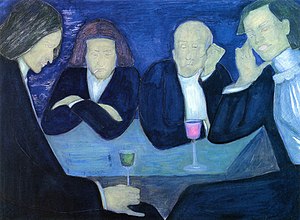In the cafe

|
| In the cafe |
|---|
| Marianne von Werefkin , 1909 |
| Tempera painting on cardboard |
| 54 x 72.2 cm |
| Fondazione Marianne Werefkin , Ascona |
In the café is the title of a painting that the Russian artist Marianne von Werefkin painted in 1909. The work belongs to the holdings of the Fondazione Marianne Werefkin (FMW) in Ascona . There it bears the inventory number FMW-0-0-14. The corresponding sketch , a colorful gouache , has the inventory number FMW-46-6-651-a23 / 24.
Technology, dimensions and labeling
It is a tempera painting on cardboard , 54 × 72.2 cm.
iconography
Orientation towards Munch
Since the beginning of her Expressionist phase, Werefkin developed a particular fondness for the painting of Edvard Munch . In her picture “In the Café” she orientated herself on his painting “Round Table” . This shows five men at a table in good company. In terms of color, the picture is initially inconspicuous. However, the bright red face of the man in the middle is strange. Noticeably, it repeats the color of the drinks on the table. Interestingly, red only appears as a background surface in Werefkin's sketch. In the picture, however, she avoided the color red. Otherwise, Werefkin's seated figures in particular, which are Japanese-style overlapping to the left and right of the edge of the picture, agree with Munch's composition.
Orientation towards Anquetin
If Werefkin followed Munch visually with her painting “In the Café” , she combined it stylistically with Anquetin's tone-on-tone painting . Different variants of blue dominate the basic tone of Werefkin's picture. It conveys a mood of disconnectedness and loneliness. The facial expressions and gestures of those portrayed play an essential role in completing the basic color mood. It symbolizes lethargy and aggressiveness at the same time. Werefkin has put the colors together dissonantly to the point of unbearable, culminating in an unusual, seemingly complementary harmony of the pink and poison green colors of the drinks.
Orientation towards Gauguin and van Gogh

The milieu of the pictorial topos of desolation used by Munch and Werefkin can also be derived from Gauguin's picture of the same name “Im Café” or Vincent van Gogh's painting Das Nachtcafé in terms of motifs and icons . With her picture, Werefkin expresses what van Gogh meant when he explained his painting to his brother Theo : “In my picture of the night café I tried to express that the café is a place where you can ruin yourself, where you can go crazy and Can commit crimes [...] I wanted to express the dark power of a pub. […] In front of my picture, the viewer would “say that it is delirium tremens in the highest stage.”
literature
- Clemens Weiler : Marianne Werefkin 1860–1938. Exhib. Cat .: Städtisches Museum Wiesbaden 1958, cat.no.23, p. 8, b / w-fig., (P. 20)
- Bernd Fäthke: Marianne Werefkin. Munich 2001, p. 128 f, fig. 133, ISBN 3-7774-9040-7
- Bernd Fäthke : Marianne Werefkin: Clemens Weiler's Legacy. In: Marianne Werefkin and the Women Artists in her Circle. (Tanja Malycheva and Isabel Wünsche eds.), Leiden / Boston 2016 (English), pp. 8–19, ISBN 978-9-0043-2897-6 , pp. 8–19, here pp. 14–19; JSTOR 10.1163 / j.ctt1w8h0q1.7
Individual evidence
- ↑ Bernd Fäthke: Marianne Werefkin. Munich 2001, p. 128 f, color illus. 133, ISBN 3-7774-9040-7
- ^ Arne Eggum: Edvard Munch's new colors and fauvism. In: Munch in France. Schirn Kunsthalle Frankfurt 1992, p. 312, color illus. 42
- ↑ The description refers to the painting: Oil on canvas, 67 × 96 cm in the Munch Museet in Oslo.
- ^ Evert van Uitert, Louis van Tilborgh, Sjraarvan Heugten: Vincent van Gogh, Paintings. Exhib. Cat .: Rijksmuseum Vincent van Gogh, Amsterdam 1990, p. 148 f, Cat.No. 58, color illus. P. 151
- ↑ Vincent van Gogh: Complete Letters, To the Family, To Friends and Acquaintances. In d. Translated by Eva Schumann. Edited by Fritz Erpel, Bornheim-Merten 1985, Vol. 4, p. 146
